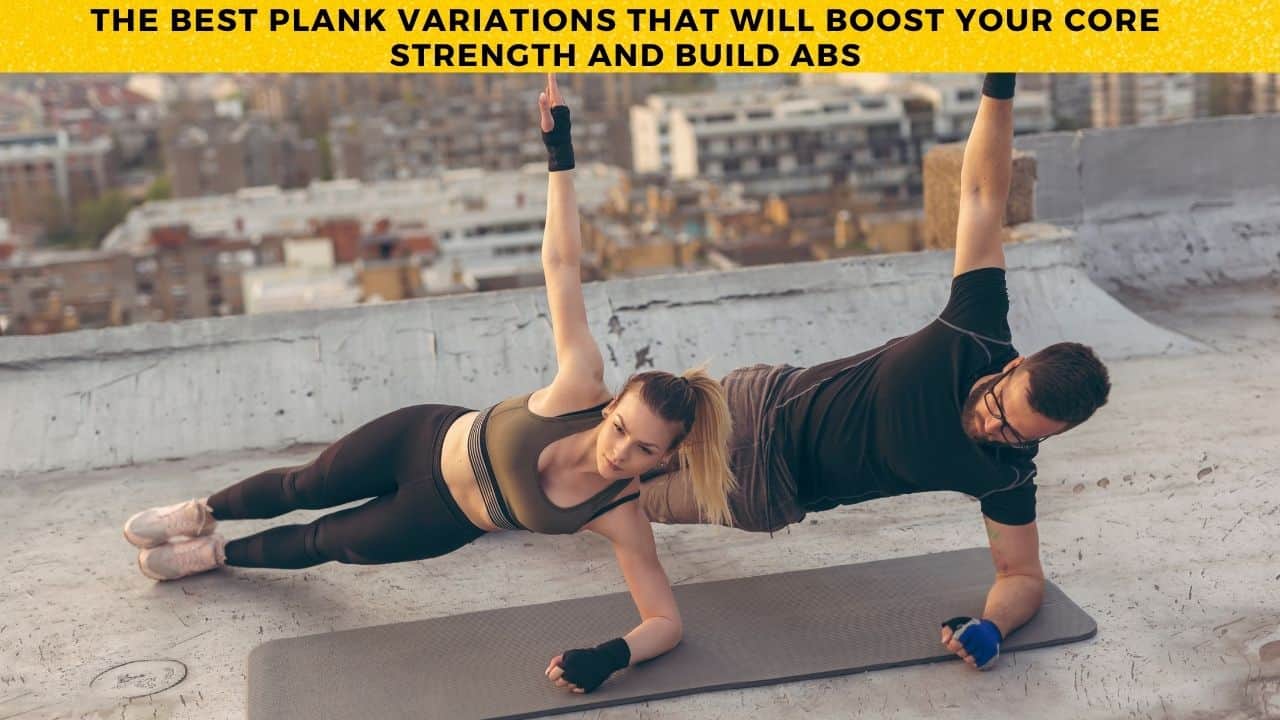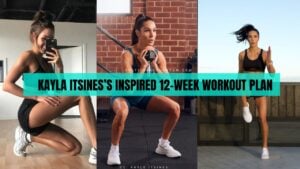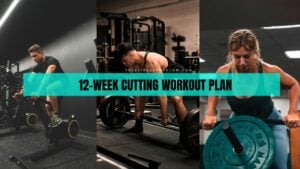Whether you’re a beginner or pro, male or female, underweight or overweight, doing plank exercises can help you strengthen and tone core muscles. From easy to advanced, there are different types of plank variations you can do at home and in the gym.
In this article, I’ll discuss everything about the plank exercise, including its different variations and benefits, and the plank workout routine.
You can incorporate these plank variations into your workout routine to build a strong core and improve your athletic and lifting performance.
Plank Workout Overview

Plank is an isometric core strengthening exercise that bolsters abdominal muscles, thickens six-pack abs, builds endurance, and improves workout performance.
From the front, lateral, and rocking plank to bird-dog, crouch hover, and extended plank, there are various types of planks you can do to hammer your midsection.
Planks are adaptable, effective, and challenging. They target multiple muscles simultaneously, primarily the abs, obliques, and shoulders.
Doing planks frequently can increase core muscle endurance, strengthen the lower back and shoulders, and improve performance.
Muscles Worked During Plank Exercises

The different plank types work on different muscle groups. For example, the front plank targets the midsection, the side plank works on the obliques, shoulders, and hips, and the bird dog plank works on the lower back, abs, obliques, and glutes.
Here’s a quick overview of all the muscles that work during planking exercises:
Primary Muscles Worked:
- Rectus Abdominis: The rectus abdominis a.k.a six-pack abs are involved in most plank variations, especially during the front planks where your torso points downward.1 Moreno-Navarro P, Sabido R, Barbado D, Prat-Luri A, Vera-Garcia FJ. Trunk muscle activation in prone plank exercises with different body tilts. J Back Musculoskelet Rehabil. 2024;37(3):743-750. doi: 10.3233/BMR-230209. PMID: 38217576, 2Bautista D, Durke D, Cotter JA, Escobar KA, Schick EE. A Comparison of Muscle Activation Among the Front Squat, Overhead Squat, Back Extension and Plank. Int J Exerc Sci. 2020 May 1;13(1):714-722. doi: 10.70252/BTUH3630. PMID: 32509107; PMCID: PMC7241624
- Obliques: The side abs or obliques work when during the lateral plank variations where you lie on your side. (1, 2)
- Shoulders: The shoulder keeps the upper body stable and prevents the back from sagging during the various plank variations. The anterior deltoids (front part of the shoulders), for example, support your torso during the front planks and the medial deltoids work when you do side planks.3 Can EN, Harput G, Turgut E. Shoulder and Scapular Muscle Activity During Low and High Plank Variations With Different Body-Weight-Bearing Statuses. J Strength Cond Res. 2024 Feb 1;38(2):245-252. doi: 10.1519/JSC.0000000000004622. Epub 2023 Oct 8. PMID: 37815235.
Secondary Muscles Worked:
- Arms: Arms also help support the body during planks. Planks require your arms to work isometrically, meaning they hold a static position without moving, which helps build strength and endurance in the biceps, triceps, and forearms.
- Lower Back: The lower back plays a crucial role in maintaining a neutral position and supporting the core during planks.4 Park DJ, Park SY. Which trunk exercise most effectively activates abdominal muscles? A comparative study of plank and isometric bilateral leg raise exercises. J Back Musculoskelet Rehabil. 2019;32(5):797-802. doi: 10.3233/BMR-181122. PMID: 30856100
- Legs: The legs are also responsible for keeping the body straight from top to bottom. So, frequent planking will also improve your lower body endurance to some extent.
The Different Variations of Planks

I’ll show you the 23 different plank variations that build a strong core and functional body.
I’ve categorized them into three groups: beginner, intermediate, and advanced. According to your fitness level, you can incorporate them into your exercise program.
Planks for Beginners
- High Plank
- Incline plank
- Knee Plank
- Reverse Plank
- Reverse plank leg raise
- Crouch hover plank
Planks for Intermediate
- Rocking plank
- Forearm plank
- Side Elbow plank
- Side Plank Hip Raise
- Reverse plank Hip Raise
- Side Plank Leg Raise
- Swiss ball Plank
Advanced Plank Variations
- Knee To Outside Elbow Plank
- Extended Plank
- Knee to Inside Elbow Plank
- Decline Plank
- Single-leg plank
- Stability Ball Side Plank
- Bird dog plank
- Single Arm Plank
- Moving Plank
- Push-ups to Plank
Okay, so let’s just quickly see how to do each plank variation with step by step guide.
Plank Variations for Beginners
1. High Plank
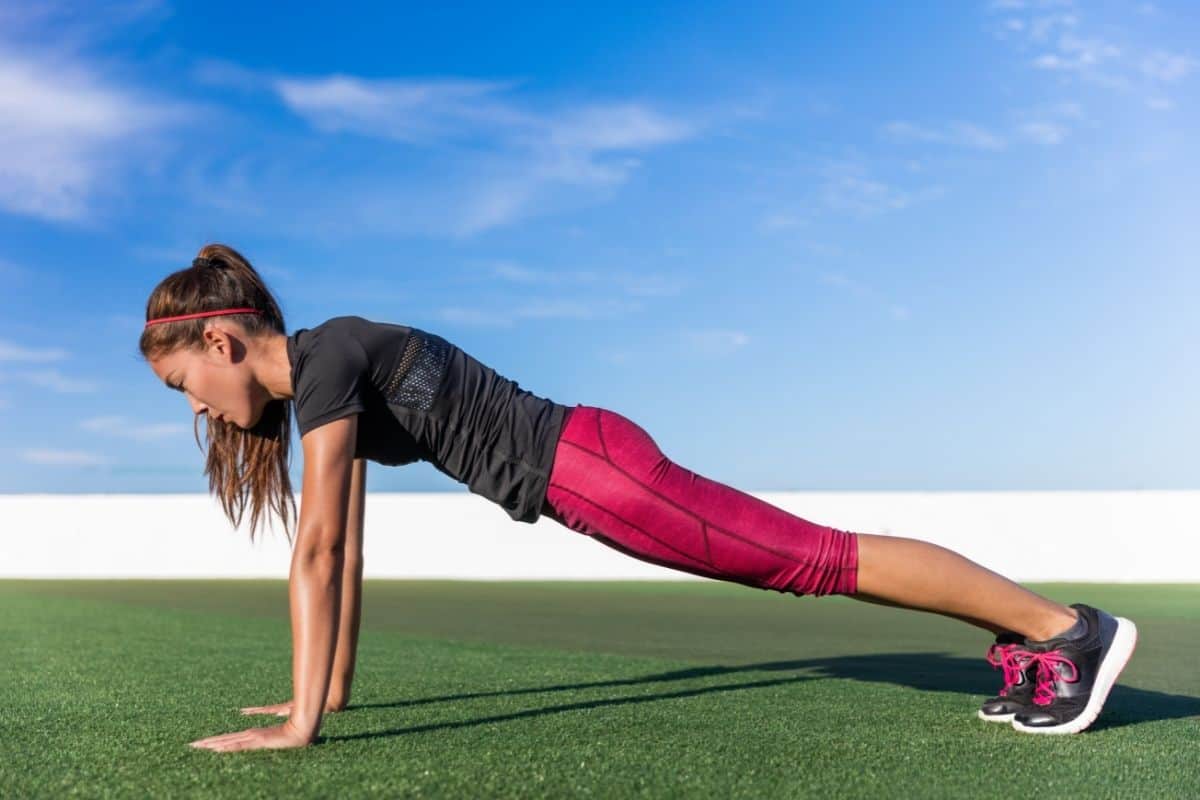
If you’re a beginner, you can do the high plank. The high plank is one of the easier planks for strengthening your abs.
It only requires you to place your palms on the ground instead of the forearm, making it easy to begin your planking.
This plank will prepare you for forearm plank variations.
Steps to do the high plank:
- Start by sitting on your knees and place your hands on the ground shoulder-width apart, with your arms straight directly underneath your shoulders.
- Kick your legs behind you to get into an “up” position or push-up.
- Make sure your weight stays on your hands and toes.
- Engaging your core, focus on abdominal muscles, and hold for 30 to 60 seconds.
2. Incline plank
Like an incline push-up, the incline forearm plank is a great exercise for beginners because it requires less strength than the traditional plank.
By doing forearm planks on an elevated position, you can build endurance and strength for floor planks.
Steps to perform an Incline Plank Hold:
- Stand straight in front of the chair, table, or box, then kneel and place your forearm on the stuff. Make sure your body makes at least a 30-45 degree incline.
- Now lift your knees off the ground and kick your legs behind you to form a straight line from head to heel.
- Make sure your weight stays on your forearms and toes.
- Brace your core and hold it in this position for at least 30 seconds.
3. Kneeling Plank

The easiest plank on this planet is the kneeling plank, yet effective for beginners and females.
It is the least effective than toe planks but an excellent way to start your core workout training.
How to do the plank on knees:
- Sit on your knees and place your forearms on the mat slightly shorter than shoulder-width apart. Make sure your arms are placed directly below your shoulders and your feet behind you.
- Keep your back as straight as possible, brace your abdominal muscles, and hold into the position for as long as you can.
4. Reverse Plank
The reverse plank involves keeping your arms straight with your face up. It strengthens the core as well as engages the arms, back, legs, and glutes, and builds a functional body.
How to do the reverse plank
- Sit on the floor on your buttocks, legs extended straight in front of you. Put your hands on the ground at your sides, fingers pointing forward.
- Now push up until your arms are extended, and make sure they’re below your shoulder and your body forms a straight line from head to toe.
- Brace your abdominal muscles and hold them in the position for the desired amount of time.
5. Reverse Plank Leg Raise
This exercise involves lifting your legs alternatively while keeping your body in reverse.
Although the reverse plank leg kicks may be slightly more difficult than the above one, they work more efficiently and can help you build a powerful core.
Steps to do the reverse plank with leg raise:
- Get into the reverse plank with your body straight, chest up, and abs tight.
- Raise your legs (alternatively) while keeping your abs engaged.
- Do this for at least 20 to 30 seconds or 8-10 times per side.
6. Crouch Hover Plank
The crouch hover plank is another basic core exercise for beginners, especially women. It helps boost abdominal strength and improve balance and posture.
Steps to do the Crouch Hover Plank:
- Get into a tabletop position on your hands and knees. Legs behind you, knees on the ground, and maintain a tight core.
- Now slightly lift your knees off the ground so your body weight stays on your hands and toes.
- Hold in this position for at least 30 seconds for a better result.
The Best Plank Types for intermediate
7. Rocking plank
If you have been working out for a while, you may try modified plank variations, like the rocking plank.
Rocking plank helps build a fitter core, flatten your stomach, and increase mobility.
How to do the rocking plank:
- Get into a normal position with your forearms slightly shorter than shoulder-width apart and below your chest.
- Keep your back straight and maintain a straight line from your head to the heels. Make sure your weight stays on your hands and toes only.
- Now tighten your core and slowly move your upper body forward by rising higher onto your toes until your shoulders cross the fingertips.
- Then slowly move in the opposite direction to get back into the starting position
8. Forearm Front Plank
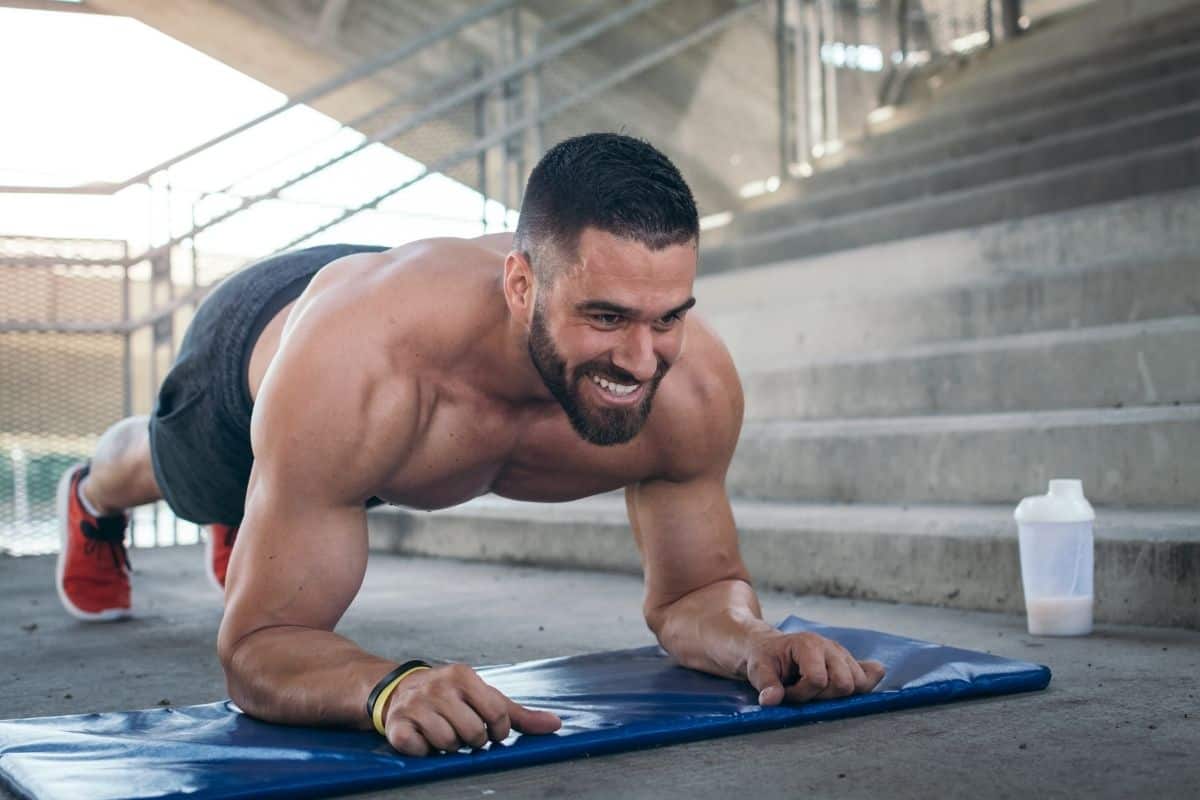
The forearm plank is the widely performed plank variation that people of various fitness communities do.
It involves holding your body on your toes and forearms and keeping your abs engaged.
The forearm plank helps increase core muscle endurance, improve posture, strengthen arms and shoulders, and most importantly, fortify the abdominal muscles.5 Choi JH, Kim DE, Cynn HS. Comparison of Trunk Muscle Activity Between Traditional Plank Exercise and Plank Exercise With Isometric Contraction of Ankle Muscles in Subjects With Chronic Low Back Pain. J Strength Cond Res. 2021 Sep 1;35(9):2407-2413. doi: 10.1519/JSC.0000000000003188. PMID: 31136542.
Steps to do the forearm plank:
- Get into a push-up position on your forearms, legs extended straight behind you, and maintain a straight line from your head to the heels.
- Hold your body weight on your forearms and toes while keeping the back straight and core tight.
- Hold in this position for as long as you can but at least 1 minute for effective results.
Pull your belly button toward your spine to engage your abs more efficiently.6 García-Jaén M, Cortell-Tormo JM, Hernández-Sánchez S, Tortosa-Martínez J. Influence of Abdominal Hollowing Maneuver on the Core Musculature Activation during the Prone Plank Exercise. Int J Environ Res Public Health. 2020 Oct 12;17(20):7410. doi: 10.3390/ijerph17207410. PMID: 33053717; PMCID: PMC7600276.
9. Forearm Side Plank

The side plank is a core-strengthening exercise that primarily bolsters the obliques (side abs). It also engages hips, arms, and shoulders and improves strength and balance.
This exercise involves the following steps:
- Start with holding your body weight on the right side of your forearm. To make it easy, keep your right arm extended below your shoulder.
- Legs are extended and piled from hip to feet, and keep your other arm on your body.
- Keep your torso straight in line, tighten your abdominal muscles, and hold into this position for the desired amount of time.
10. Side Plank Hip Raise
The side plank hip raise is a modified side plank variation and involves hip movement.
It is a lower-back-friendly exercise that toughens the core, especially the obliques and improves balance and coordination.
Steps to Side Plank Hip Raises:
- Get into a side plank with your forearm/hand on the ground below your shoulder and body straight from top to bottom.
- Lower your hips slowly toward the floor without touching it and then lift them again.
- Do it 8-10 times, then switch to the opposite side and repeat.
Find difficult? Well, you can make it a bit easier by bending your knees and even more easier by putting your side knees on the ground.
11. Side Plank Leg Raise
The side plank leg raise is another way to hammer your obliques and build an athletic midsection, and decent mobility.
It also improves hip functionality and develops a more functionally fit body.
Here are the steps to do the side plank leg raise:
- Begin by holding your body weight on the right side of your forearm. Your forearm should be underneath your shoulder.
- Keep your legs extended straight in line, one leg on the other, and make sure your weight stays on the forearm and the side feet.
- Keep your torso straight in line, tighten your abdominal muscles, and raise your left leg as high as you can.
- You can hold it for a couple of seconds at the top, then lower it down into the starting position.
12. Reverse Plank Hip Raise
The reverse plank hip raise is one of the key variations of plank that works on the core and strengthens the lower back.
It also improves flexibility, muscle coordination, balance, and hip mobility.
Steps to perform a Reverse Plank Hip Raise:
- Sit on the floor, legs extended straight in front of you, and place your hands on the ground behind you, fingers pointing opposite to the body.
- Now push up until your arms are extended, and make sure they’re below your shoulder and your body forms a straight line from head to toe.
- Now tighten your abdominal muscles, then slowly lower your hips toward the floor without touching them, and then lift them again.
13. Swiss ball Plank

The Swiss ball plank is one of the highly effective core workouts that simultaneously strengthen the rectus abdominis, external oblique, and erector spinae.
Performing plank on stability devices such as Swiss ball produces higher muscle activation in your core (rectus abdominis and oblique) – showed in research published by the Journal Strength and Conditioning Research.
So if you have access to a Swiss ball, do plank on it. You’ll surely enjoy it.
Here’s how to do the Swiss ball plank:
- Sit on your knees in front of the Swiss ball.
- Place your forearms on the ball.
- Lift your knees off the floor so you’re in an elevated plank position.
- Keep your core and glutes tight and your back as flat as possible. Hold in this position for as long as you can.
- Once you no longer hold, safely return to the normal position.
The Best Advanced Level Plank Exercises
Once you mastered the beginner and intermediate-level plank exercises, you should try to perform the advanced plank variations. These are challenging but super effective and will take your abdominal strength and endurance to a higher level.
14. Knee To Outside Elbow Plank
The knee-to-outside elbow plank (also known as spider plank) works on several muscles, especially the obliques and lower abs.
Performing the spider plank can also serve as a cardio exercise, as it increases heart rate and burns a good number of calories.
Here’s how you can do that:
- Get into a push-up position on your forearms, legs extended straight behind you, and maintain a straight line from your head to the heels.
- Hold your weight on your forearms and toes while keeping the back straight and core tight. That’s your starting position.
- Now bring your right knee out toward the right elbow. Then return to the starting position and repeat on the other side to complete one rep.
- Do it as many times as you like.
To make it easier, you can do it in a straight-arm plank position.
15. Extended Plank
The extended plank involves placing your forearms or hands further away from your shoulders. This extended variation stretches abdominal muscles and forces your core to work hard to maintain stability.
If you have been working out for a while, you can include it in your plank exercise routine to bolster your midsection and improve flexibility.
How to do the extended plank:
- Place your hands on the ground, above your head level.
- Get on your toes, maintain a neutral spine, and brace your abs and legs.
- Hold in this position for 30-60 seconds, then return to the start.
To make it harder, you can place your forearms on the ground, instead of your hands.
16. Knee to Inside Elbow Plank
The knee-to-inside elbow plank involves bringing your knee toward the opposite, engaging your lower abs and obliques simultaneously.
This exercise helps you improve your hip mobility, and six-pack appearance, and build endurance. So, make sure you include it in your core workout plan.
Knee to Inside Elbow Plank involves the following steps:
- Get into a push-up position with your arms extended and slightly wider than shoulder-width, legs extended behind you, and maintain a straight line from your head to the heels.
- Hold your weight onto your hands and toes while keeping the back straight and core tight. That’s your starting position.
- Now bend your right knee and bring it from inside toward the left elbow. Hold for a moment if you want, then return your leg to the starting position and repeat on the other side to complete one rep.
17. Decline Plank
The decline plank not only improves core strength but also works on the shoulder. The elevated position of the plank puts more stress on the shoulder and increases shoulder strength. But avoid it if you have any shoulder pain issues.
How to do the decline plank:
- Get into a forearm plank position with your legs extended behind you on 30-45-degree incline stuff like a bench, chair, table, medicine ball, etc. Keep your body straight in an elevated position from top to bottom.
- Maintain a tight core and hold in this position for 30-45 seconds at least for a good result.
18. Single-leg Modified Plank
If you want to enhance your balance and mobility while strengthening core muscles, try a single-leg modified plank. The single-leg plank involves lifting your one leg off the floor, making it challenging for you to maintain balance.
Here are the steps to do the single-leg plank:
- Assume a push-up position with your forearms on the ground and below the shoulder.
- Keep your back straight and core tight, and raise your one leg until it is parallel to the floor.
- Hold for 5-10 seconds at the top, then lower it down and repeat the same with your other leg.
- The duration of this plank is up to you and your strength.
19. Stability Ball Side Plank
The stability ball side plank reinforces external and internal oblique and helps you build a powerful core. Keeping your elbow on an unstable surface like a stability ball also helps improve your balance and muscle coordination.
How to do the side plank on a stability ball:
- Place your right elbow on the stability ball and lie on your side with your legs straight and hips stable.
- Brace your abs and hold in this position for as long as possible.
If you want to fortify your side abs, add dumbbells for added resistance. You can also try these dumbbell oblique exercises.
20. Bird Dog Plank

The bird dog plank is one of the super effective exercises for developing posterior chain muscles, including the core.7 Calatayud J, Escriche-Escuder A, Cruz-Montecinos C, Andersen LL, Pérez-Alenda S, Aiguadé R, Casaña J. Tolerability and Muscle Activity of Core Muscle Exercises in Chronic Low-back Pain. Int J Environ Res Public Health. 2019 Sep 20;16(19):3509. doi: 10.3390/ijerph16193509. PMID: 31547140; PMCID: PMC6801665
It helps improve lower back strength, overall balance, and posture. The best thing is it is suitable for all fitness enthusiasts.
How to do the bird dog plank:
- Get into a high plank position with your legs extended behind, maintain some space between your legs about shoulder-width, and keep your back straight and core tight. That’s your starting position.
- Now begin to raise your right arm and left leg at the same time until they are parallel to the floor.
- Hold for a moment at the top, then slowly lower it down. Then repeat this movement with your opposite side.
- This is one of the difficult plank types, so do this for the desired amount of time.
21. Single Arm Modified Plank
If you think you’re better at intermediate planking, try this single-arm modified plank. The one-arm plank is one of the advanced variations requiring good balance, core strength, and endurance.
To do the single-plank
- Get into a normal forearm plank position with your legs straight behind you. Keep your body straight from top to bottom. That’s the starting position.
- Tight your abs and glutes muscles and slowly lift your one arm up until it is parallel to the floor.
- Bring it down and lift the other one, hold and return to the floor to complete one rep. Do as many reps as you can.
- Keep your body firm to avoid any disbalance during the movement.
22. Moving Plank
Where do I need to move? Well, you can move your right, left, forward, and backward.
This plank variation is walking on your forearms and toes.
If you can do a standard forearm plank, you can also do this.
Here are the steps for how to do a moving plank
- Get yourself into a forearm plank position, keep your core tight and back straight, and make sure your weight stays on your forearms and toes.
- Now slowly move toward the right (8-10 inches from the middle), then return to the beginning, then move to the left and again return to the beginning, in the same way, repeat in the other two directions.
- Do this for the desired amount of time.
23. Push-ups to Plank
The push-ups to plank work on various muscles such as the back, chest, arms, core, and hips. Not only this, but it also stabilizes spinal muscles and improves coordination.
How to Push-up Plank:
- Start with a high plank position, with your arms extended and placed below your shoulders.
- keep your core tight and back straight and make sure your weight stays on your hands and toes. That’s the beginning position.
- Now lower down on your one forearm followed by the other, so you’re now in a forearm plank position.
- To do the final step, push the floor with one arm followed by the other to return to the high plank position. That’s one complete rep! Do the desired number of repetitions.
- Keep your core tight during the whole movement.
Weekly Plank Exercise Routine
Here I’ll share some plank exercise routines for different fitness levels, such as beginner, intermediate, and pro. So depending on your fitness level, you can do one of them.
Beginners
Monday
- High Plank – 30 seconds x 2
- Incline plank – 30 seconds x 2
- Knee Plank – 30 seconds x 2
Wednesday
- Reverse Plank – 20 seconds x 2
- Reverse plank leg raises -20 seconds x 2
- Crouch hover plank – 30 seconds x 2
Friday
- Forearm plank – 30 seconds x 2
- Side Elbow plank – 20 seconds x 2
- Side Plank Hip Raise – 20 seconds x 2
For Intermediate
Day 1
- Forearm plank – 60 seconds x 2
- Side Elbow plank – 30 seconds x 2
- Rocking plank – 60 seconds x 2
Day 2
- Side Plank Hip Raise – 30 seconds x 2
- Extended Pank – 60 seconds x 2
- Side Plank Leg Raise – 30 seconds x 2
- Swiss ball Plank – 60 seconds x 2
Day 3
- Forearm plank – 60 seconds x 2
- Side plank – 30 seconds x 2
- Knee To Outside Elbow Plank – 45 seconds x 2
- Knee to Inside Elbow Plank – 45 seconds x 2
Day 4
- Extended Plank – 60 seconds x 2
- Single-leg plank – 45 seconds
- Single-arm plank – 45 seconds
- Swiss ball Plank – 60 seconds x 2
- Stability Ball Side Plank -30 seconds x 2
Advanced Plank Routine
Day 1
- Forearm Plank – 2 minutes x 2
- Knee To Outside Elbow Plank – 60 seconds x 2
- Extended Plank – 90 seconds x 2
- Knee to Inside Elbow Plank – 90 seconds x 2
Day 2
- Decline Plank – 90 seconds x 2
- Single Arm Plank – 60 seconds x 2
- Single-Leg Plank – 60 seconds x 2
- Stability Ball Side Plank – 2 minutes x 2
Day 3
- Bird Dog Plank – 60 seconds on each side
- Push-ups to Plank – 60 seconds x 2
- TRX Plank – 60 seconds x 2
- Reverse Plank Hip Raise – 45 seconds x 2
Day 4
- Forearm Plank – 2 minutes x 2
- Knee To Outside Elbow Plank – 60 seconds x 2
- Extended Plank – 90 seconds x 2
- Knee to Inside Elbow Plank – 90 seconds x 2
Day 5
- Bird Dog Plank – 60 seconds on each side
- Push-ups to Plank – 60 seconds x 2
- TRX Plank – 60 seconds x 2
- Reverse Plank Hip Raise – 45 seconds x 2
Download The Plank Workout PDF
You can download the PDF of these plank exercises if you want to keep them handy.
The Bottom Line
Whether you’re an athlete, powerlifter, or bodybuilder, you can do planks to bolster your core strength, thicken your six-pack ab muscles, and reduce abdominal fat.
There are various kinds of plank you can do at home. For example, I’ve shared more than twenty plank variations in this article that can help you forge your core. Depending on your fitness level, you can do some of them.
A stronger core provides stability to your lower back, minimizes the risk of injuries, enhances athletic and lifting performance, and helps improve posture.
Once you complete these exercises, you can then move on to weighted plank variations.
References
- 1Moreno-Navarro P, Sabido R, Barbado D, Prat-Luri A, Vera-Garcia FJ. Trunk muscle activation in prone plank exercises with different body tilts. J Back Musculoskelet Rehabil. 2024;37(3):743-750. doi: 10.3233/BMR-230209. PMID: 38217576
- 2Bautista D, Durke D, Cotter JA, Escobar KA, Schick EE. A Comparison of Muscle Activation Among the Front Squat, Overhead Squat, Back Extension and Plank. Int J Exerc Sci. 2020 May 1;13(1):714-722. doi: 10.70252/BTUH3630. PMID: 32509107; PMCID: PMC7241624
- 3Can EN, Harput G, Turgut E. Shoulder and Scapular Muscle Activity During Low and High Plank Variations With Different Body-Weight-Bearing Statuses. J Strength Cond Res. 2024 Feb 1;38(2):245-252. doi: 10.1519/JSC.0000000000004622. Epub 2023 Oct 8. PMID: 37815235.
- 4Park DJ, Park SY. Which trunk exercise most effectively activates abdominal muscles? A comparative study of plank and isometric bilateral leg raise exercises. J Back Musculoskelet Rehabil. 2019;32(5):797-802. doi: 10.3233/BMR-181122. PMID: 30856100
- 5Choi JH, Kim DE, Cynn HS. Comparison of Trunk Muscle Activity Between Traditional Plank Exercise and Plank Exercise With Isometric Contraction of Ankle Muscles in Subjects With Chronic Low Back Pain. J Strength Cond Res. 2021 Sep 1;35(9):2407-2413. doi: 10.1519/JSC.0000000000003188. PMID: 31136542.
- 6García-Jaén M, Cortell-Tormo JM, Hernández-Sánchez S, Tortosa-Martínez J. Influence of Abdominal Hollowing Maneuver on the Core Musculature Activation during the Prone Plank Exercise. Int J Environ Res Public Health. 2020 Oct 12;17(20):7410. doi: 10.3390/ijerph17207410. PMID: 33053717; PMCID: PMC7600276.
- 7Calatayud J, Escriche-Escuder A, Cruz-Montecinos C, Andersen LL, Pérez-Alenda S, Aiguadé R, Casaña J. Tolerability and Muscle Activity of Core Muscle Exercises in Chronic Low-back Pain. Int J Environ Res Public Health. 2019 Sep 20;16(19):3509. doi: 10.3390/ijerph16193509. PMID: 31547140; PMCID: PMC6801665

